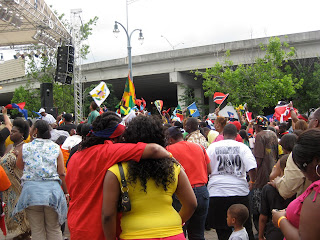 |
| The Journey |
It is amazing how quickly a year can go by. I can’t believe that more than 365 days ago have come and gone since I packed up my things and moved “down South” to Atlanta, aiming to document and examine Afro-Caribbeans and lives in the southern metro area for my dissertation research (for the non-academics, this is the big research project/paper before you get a PhD). A few weeks after I arrived, I decided to start this blog as a fun and easy way to write up my data, while sharing with others my experiences, as a Caribbean American researcher, in Atlanta. Knowing that scarcely anything has been written about the growing Caribbean community in Atlanta, I thought a blog would be a great way to immediately present information about this growing community in the Atlanta area.
Ideally, I thought I would be able to give daily, or at least weekly, accounts of my Caribbean experience in the A—from going to Caribbean parties and events, eating at Caribbean restaurants, talking to other Caribbean people, and navigating southern life as a Caribbean American. However, as you can see from my few posts over the past 12 months, neither the daily nor weekly blogging happened. I didn’t even get close to monthly blogging (*embarrassed face*). I let other things, such as interviewing, observing, eating, sleeping, watching TV, staring into space, among other seemingly important things, come before my first priority, as an academic: writing.
It does not dome much good to go out, talk to people, and collect data, if I do not write it all down in the end. As an academic, my career advancement is pretty much dependent on how much I write (i.e., publish). I need to write to get a professorship. I need to write to get research funding. I need to write to get to tenure (that oh so coveted lifetime job security). But, most importantly, before all of that, I need to write to get my PhD (I want to see that DR in front of my name, baby!!!). In short, no written dissertation equals no degree.
The paucity of my blog posts is a visible sign that I have been slacking on my writing. To be honest, I have been damn near avoiding it like I owe it money. Fortunately, my avoidance of writing has not translated to an avoidance of my research. Over the past 12 months, I have spent countless hours attending Caribbean events, talking to Caribbean people, eating Caribbean foods, listening to Caribbean music, and exploring my own Caribbean identity. I have even presented some of the things that I have learned about Caribbean life in Atlanta at two different academic conferences this summer; thus far, my work has been very well received by my academic peers.
Knowing that my work is well received in the academic world fuels my desire to have my work well received by the public—the people I write about, the people I want to read my articles and books, and the people who follow me (hopefully still follow me) out there in the blogosphere. So, from here on, I promise to try my best to update my blog as regularly as possible. I now know that I am not going to be able to post daily like I had originally hoped last June, but I can try, with the help of a good writing schedule, to post weekly about specific topics, events, observations, etc from my yearlong experience in Caribbean Atlanta.
I hope you will join me on the new phase of my life journey/academic endeavor and check in each week to read about the observations of this Afro-Caribbean in Atlanta.
My next topic will be about the Caribbean club scene in the ATL.
 |
| Heading towards the next phase |
















